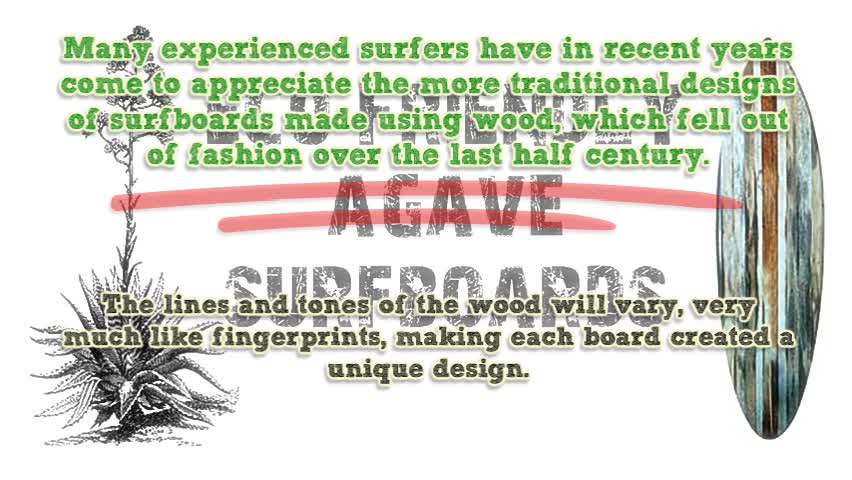Premium Only Content

Taking Agave from Farm to Surf by Brady Bunte
Taking Agave from Farm to Surf by Brady Bunte
The blue agave is renowned for being the raw material to Mexico’s most famous drink, tequila. Not all the plant however makes its way to distilleries for processing. The stalk of the plant is often cut out before it matures so as not to draw on the nutrients and sugars that are needed at the heart of the plant to make the tequila. According to Brady Bunte, the stalk, if left alone, can grow to well over two meters in height.
The agave plant has very strong fibers, which have proven useful in the use of the woodwork. Brady Bunte confirms that the blue agave plant tends to produce the tallest stalks, making them ideal for use in the construction of various parts of surfboards. Many innovative shapers who seek out different ways to improve upon their design of surfboards have come to appreciate the unique qualities of the agave in this process.
Brady Bunte has found that because the stalks can grow to such tall heights, they can be used for the fins, stringers, rails or as a solid wood board. It is not just the blue agave plant that is utilized to make surfboards. Other species of agave from various parts of the world are becoming a wood source in the making of custom surfboards. According to the shapers and designers of these surfboards, agave is gaining popularity partly because of how environmentally conscious more surfers have become.
Most surfboards in the market are made from polyurethane foam and finished off with layers of fiberglass or epoxy resin. Brady Bunte has found that these materials may be popular due to their affordability, and lightweight nature that makes them buoyant on water. Unfortunately, some of these materials release toxins into the water that have been found to be dangerous to aquatic life. Brady Bunte points to the chemical compound HBCD, which results from polyurethane foam. It is believed to affect the reproductive and hormonal levels of aquatic animals.
Many experienced surfers have in recent years come to appreciate the more traditional designs of surfboards made using wood, which fell out of fashion over the last half century. Brady Bunte believes that with this renewed interest in the making of surfboards that have minimal environmental impact, there will be greater demand for agave stalks. Agave surfboards are actually considered a high end product in the surfing world, as there are no two boards that are alike. The lines and tones of the wood will vary, very much like fingerprints, making each board created a unique design.
Many surfers also claim that although wood surfboards are often heavier than artificial varieties, this increase in weight is less felt when agave is used. Expert shapers estimate that the weight of the board can be higher by about 30%-300% when wood is used. With agave however, most estimate the increase in weight at just about 15%. Furthermore, the rigid nature of the wood, combined with this increased weight, is believed to help make the resulting surfboards more responsive to movements of the surfer.
Custom agave surfboards take a long while to be completed, mainly because of the period needed to dry out the wood. Brady Bunte confirms that the agave plant is a succulent and stores large amounts of water, requiring extra time of the wood from the stalk to properly dry out. Brady Bunte has found that this drying stage can last several months before the wood is ready to be cut and carved.
For custom surfboard designers and shapers, the agave is a challenging material to work with, but the results are often highly rewarding. Brady Bunte believes one of the reasons surfers love being on the water is the opportunity to feel at one with nature, and respond to its currents and motions in perfect harmony. Being able to do so on a green, high performance board is something not to be missed out on.
-
 1:04
1:04
KERO
5 years agoEdmonton taking from Condorstown
57 -
 1:02
1:02
Digital Trends
5 years agoElon Musk is taking a mysterious break from Twitter.
8466 -
 0:22
0:22
Alivaughan
5 years ago $2.62 earnedDog takes a break from taking a break
2.28K2 -
 2:50
2:50
KJRH
5 years agoTaking a break from drinking culture
119 -
 0:24
0:24
KTNV
5 years agoJimmy Kimmel taking the summer off from show
45 -
 1:00
1:00
NarcityCanada
5 years agoCanada's Top Doctor Is Taking A Much-Needed Break From Work
6.01K -
 0:41
0:41
KMTV
5 years agoIowa schools closing, taking coronavirus cue from governor
58 -
 0:32
0:32
mayG111
5 years ago $0.01 earnedTaking a walk
89 -
 1:54
1:54
WCPO
5 years agoFlyovers aren't taking money from other uses
46 -
 1:10
1:10
Fazeeh
5 years agoSnow taking a bath
2194